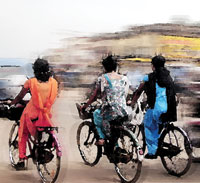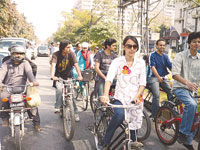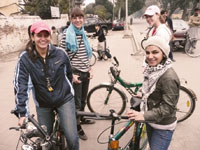
The candelight vigil for Salman Taseer held outside the Governor House in Lahore can perhaps be deemed a success, depending on your perspective. Blogger Raza Rumi claims on Twitter that around 2000 people attended, that figure leaves me entirely surprised. I didn't do a head count but surely it seemed much less than 2000. The last protest i attended after the Swat flogging video was released had a far greater number of people participating and they also seemed to be from a wider cross-section. Today it was the usual suspects. LGS Principals, NGO aunties and other fashionable members of civil society who have now (understandably) diverted paths with the lawyers they stood up for a short while back. The biggest turnout you saw from the civil society was during the Lawyers movement, the vigil for Salman Taseer came nowhere near that.
I don't say NGO aunty or the 'fashionable' in a necessarily derisive way, it is just that a handful of these people, many of whom must have personally known the slain Governor aren't really representative of any fictionary 'silent majority'. The only scarf I saw was on the very left wing head of Daily Times op-ed Mehmal Sarfraz. The rest were all streaked. Don't mind the over simplification, but I just point out the obvious physical appearances to drive home a point. While 'Mulla gardee naheen chalay gi' on the top of my lungs helped me vent some of my pent up frustration at being a citizen of a state where my religion will always be the business of everyone else, it didn't really do anything to increase my hope in the prospect of a budding liberal Pakistan.
I know enough of the mindset of the majority to be certain that jeans clad, streaked, English spewing lads and ladies will be immediately dismissed as 'dehriyay' and 'laa-deen'. Once one is dismissed as that there is no further room for another nuanced analysis. It is a class thing, and today's vigil, though an extremely essential step, whether or not it has any far reaching implications, is ultimately just another exercise in Pakistani class differences. There were of course PPP workers as well, but where was the vast majority of the 'average' man. Half of those condemn the act of killing but would never be able to raise their voices to the chant 'Mazhab ke naam pe siyaasat band karo'. (Stop politics in the name of religion), while the other half is busy throwing flowers at a ruthless murderer.
I must add, though, that I WAS heartened at the number of women present.
I wish the vigil had been held at the Liberty Market roundabout, though, for at least that would have helped in creating greater nuisance value.
Perhaps a better assessment of the general public's views was to be had from two pedestrians who were marvelling at the 'be-hayaaee' of those participating in the vigil.
The biggest show of bravery I saw, interestingly, was not outside the Governor's House. I rushed from the vigil to pick my son up from a classfellow's birthday and on my way to Defence I saw this car. I am sure this person did not participate in the vigil, so it was nice to see that similar sentiments were being expressed elsewhere as well

But, the most heartening part of the day was neither of the above events, it was what I saw in the morning that truly delighted me. I saw two young girls riding a motorcycle bang in the middle of Gulberg, a little nervous, yes, but for the most part quite confident. They did not look like they were from the privileged set who can get away with most anything, but the one sitting behind was wearing a black coat and trousers while the one driving was in more traditional clothes. It was quite a sight to behold. Most men around them seemed too stunned to even try to harass them. As luck would have it, i was driving, so I was unable to get a clear picture. But perhaps it is just as well that you cannot see their faces and can just sense their joy. (I really hope, for the sake of my romantic imagination that they reached home looking just as happy).


 Rock & Roll Jihad: A Muslim Rock Star’s Revolution
Rock & Roll Jihad: A Muslim Rock Star’s Revolution
 Tikka, the starting point for the Critical Mass rides. It was a relief to see that some other brave women had also showed up with their bicycles and were willing to be a part of the phenomenon. That first ride proved that there was far less cause for apprehension than I had first imagined.
Tikka, the starting point for the Critical Mass rides. It was a relief to see that some other brave women had also showed up with their bicycles and were willing to be a part of the phenomenon. That first ride proved that there was far less cause for apprehension than I had first imagined.